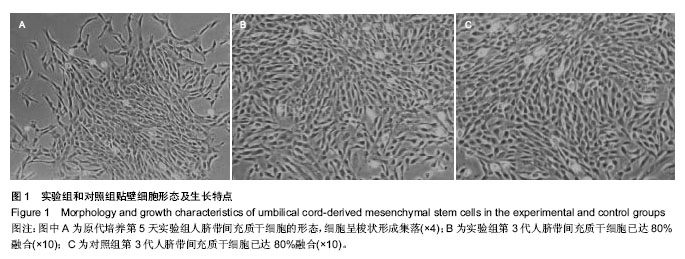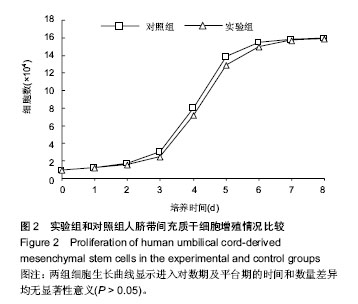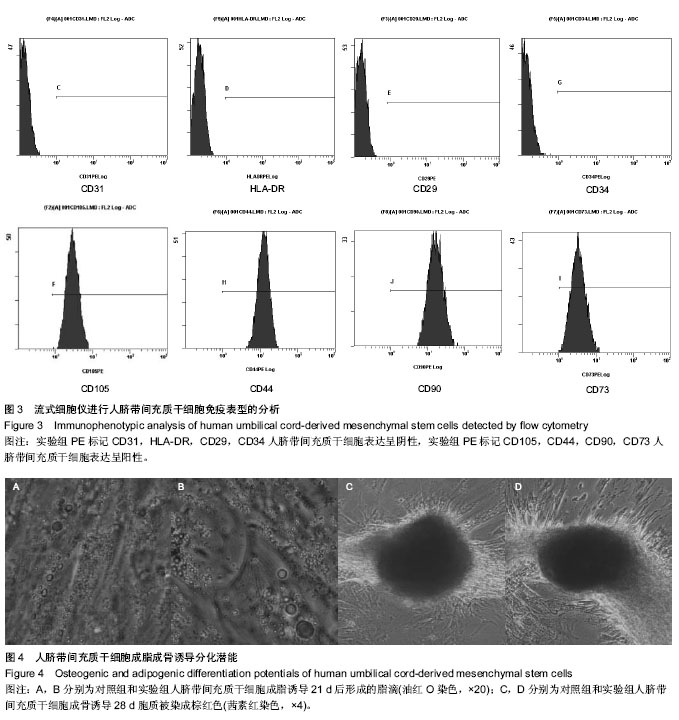| [1] Thanabalasundaram G, Arumalla N, Tailor HD,et al. Regulation of differentiation of mesenchymal stem cells into musculoskeletal cells.Curr Stem Cell Res Ther. 2012;7(2):95-102.
[2] Ghaedi M, Soleimani M, Shabani I, et al. Hepatic differentiation from human mesenchymal stem cells on a novel nanofiber scaffold.Cell Mol Biol Lett. 2012;17(1):89-106.
[3] He D, Wang J, Gao Y, et al. Differentiation of PDX1 gene- modified human umbilical cord mesenchymal stem cells into insulin-producing cells in vitro.Int J Mol Med. 2011;28(6): 1019-1024.
[4] Ma K, Fox L, Shi G, et al. Generation of neural stem cell-like cells from bone marrow-derived human mesenchymal stem cells.Neurol Res. 2011;33(10):1083-1093.
[5] Wu H, Deng Y, Yan Y, et al.Adipose differentiation and adipose tissue engineering of bone marrow-derived mesenchymal stem cells using pluronic F-127 hydrogel in vitro.Sheng Wu Yi Xue Gong Cheng Xue Za Zhi. 2011;28(6):1148-1153.
[6] Hung SC, Chen NJ, Hsieh SL,et al. Isolation and characterization of size-sieved stem cells from human bone marrow.Stem Cells. 2002;20(3):249-258.
[7] Dennis JE, Charbord P. Origin and differentiation of human and murine stroma.Stem Cells. 2002;20(3):205-214.
[8] Guo Z, Li H, Li X,et al. In vitro characteristics and in vivo immunosuppressive activity of compact bone-derived murine mesenchymal progenitor cells.Stem Cells. 2006;24(4): 992-1000.
[9] Cao Y, Sun Z, Liao L,et al. Human adipose tissue-derived stem cells differentiate into endothelial cells in vitro and improve postnatal neovascularization in vivo.Biochem Biophys Res Commun. 2005;332(2):370-379.
[10] Herzog EL, Chai L, Krause DS. Plasticity of marrow-derived stem cells. Blood. 2003;102(10):3483-3493.
[11] Pittenger MF, Mackay AM, Beck SC,et al. Multilineage potential of adult human mesenchymal stem cells.Science. 1999;284(5411):143-147.
[12] Fukuchi Y, Nakajima H, Sugiyama D, et al. Human placenta-derived cells have mesenchymal stem/progenitor cell potential.Stem Cells. 2004;22(5):649-658.
[13] Battula VL, Bareiss PM, Treml S,et al. Human placenta and bone marrow derived MSC cultured in serum-free, b-FGF-containing medium express cell surface frizzled-9 and SSEA-4 and give rise to multilineage differentiation. Differentiation. 2007;75(4):279-291.
[14] Rebelatto CK, Aguiar AM, Moretão MP,et al. Dissimilar differentiation of mesenchymal stem cells from bone marrow, umbilical cord blood, and adipose tissue. Exp Biol Med (Maywood). 2008;233(7):901-913.
[15] Panepucci RA, Siufi JL, Silva WA Jr,et al. Comparison of gene expression of umbilical cord vein and bone marrow-derived mesenchymal stem cells.Stem Cells. 2004;22(7):1263-1278.
[16] Shih DT, Lee DC, Chen SC,et al. Isolation and characterization of neurogenic mesenchymal stem cells in human scalp tissue.Stem Cells. 2005;23(7):1012-1020.
[17] Markov V, Kusumi K, Tadesse MG,et al. Identification of cord blood-derived mesenchymal stem/stromal cell populations with distinct growth kinetics, differentiation potentials, and gene expression profiles.Stem Cells Dev. 2007;16(1):53-73.
[18] Kestendjieva S, Kyurkchiev D, Tsvetkova G,et al. Characterization of mesenchymal stem cells isolated from the human umbilical cord.Cell Biol Int. 2008;32(7):724-732.
[19] Sarugaser R, Lickorish D, Baksh D,et al. Human umbilical cord perivascular (HUCPV) cells: a source of mesenchymal progenitors.Stem Cells. 2005;23(2):220-229.
[20] Wang HS, Hung SC, Peng ST,et al. Mesenchymal stem cells in the Wharton's jelly of the human umbilical cord.Stem Cells. 2004;22(7):1330-1337.
[21] Fu YS, Cheng YC, Lin MY,et al. Conversion of human umbilical cord mesenchymal stem cells in Wharton's jelly to dopaminergic neurons in vitro: potential therapeutic application for Parkinsonism.Stem Cells. 2006;24(1):115-124.
[22] Weiss ML, Medicetty S, Bledsoe AR,et al. Human umbilical cord matrix stem cells: preliminary characterization and effect of transplantation in a rodent model of Parkinson's disease. Stem Cells. 2006;24(3):781-792.
[23] Kadivar M, Khatami S, Mortazavi Y,et al. In vitro cardiomyogenic potential of human umbilical vein-derived mesenchymal stem cells.Biochem Biophys Res Commun. 2006;340(2):639-647.
[24] Ma L, Feng XY, Cui BL,et al. Human umbilical cord Wharton's Jelly-derived mesenchymal stem cells differentiation into nerve-like cells.Chin Med J (Engl). 2005;118(23):1987-1993.
[25] 李德华,单伟,郑晓明,等.人脐静脉间充质干细胞体外诱导分化为神经元的可行性[J].中国组织工程研究与临床康复,2008,12(8): 1472-1476.
[26] 王爱红,何红燕,罗敏洁,等.人脐带间充质干细胞向胰岛样细胞的分化[J].中国组织工程研究与临床康复,2008,12(21):4102- 4106.
[27] Covas DT, Siufi JL, Silva AR, et al. Isolation and culture of umbilical vein mesenchymal stem cells.Braz J Med Biol Res. 2003;36(9):1179-1183.
[28] Jomura S, Uy M, Mitchell K,et al. Potential treatment of cerebral global ischemia with Oct-4+ umbilical cord matrix cells.Stem Cells. 2007;25(1):98-106.
[29] Aranguren XL, McCue JD, Hendrickx B,et al. Multipotent adult progenitor cells sustain function of ischemic limbs in mice.J Clin Invest. 2008;118(2):505-514.
[30] Covas DT, Siufi JL, Silva AR, et al.Isolation and culture of umbilical vein mesenchymal stem cells.Braz J Med Biol Res. 2003;36(9):1179-1183.
[31] Zeddou M, Briquet A, Relic B,et al. The umbilical cord matrix is a better source of mesenchymal stem cells (MSC) than the umbilical cord blood.Cell Biol Int. 2010;34(7):693-701.
[32] 张幸国,黄明珠,魏泽庆,等.三种碳青霉烯类抗生素对ICU分离菌株的体外抗菌作用[J].中国抗生素杂志,2001,26(4):283-285.
[33] Wang HS, Hung SC, Peng ST,et al. Mesenchymal stem cells in the Wharton's jelly of the human umbilical cord.Stem Cells. 2004;22(7):1330-1337.
[34] Troyer DL, Weiss ML.Wharton's jelly-derived cells are a primitive stromal cell population.Stem Cells. 2008;26(3):591- 599.
[35] Fu YS, Cheng YC, Lin MY,et al. Conversion of human umbilical cord mesenchymal stem cells in Wharton's jelly to dopaminergic neurons in vitro: potential therapeutic application for Parkinsonism.Stem Cells. 2006;24(1):115-124.
[36] Ohgushi H, Caplan AI.Stem cell technology and bioceramics: from cell to gene engineering.J Biomed Mater Res. 1999; 48(6): 913-927.
[37] Awad HA, Butler DL, Boivin GP,et al. Autologous mesenchymal stem cell-mediated repair of tendon.Tissue Eng. 1999;5(3):267-277.
[38] Dominici M, Le Blanc K, Mueller I,et al. Minimal criteria for defining multipotent mesenchymal stromal cells. The International Society for Cellular Therapy position statement. Cytotherapy. 2006;8(4):315-317.
[39] Baksh D, Yao R, Tuan RS.Comparison of proliferative and multilineage differentiation potential of human mesenchymal stem cells derived from umbilical cord and bone marrow.Stem Cells. 2007;25(6):1384-1392. |



.jpg)